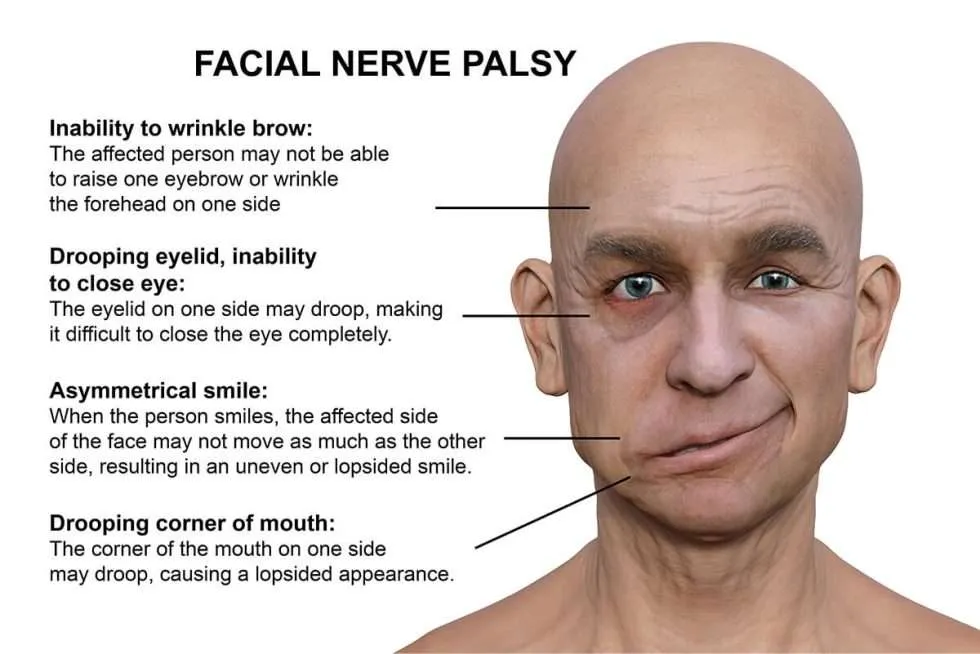Bell’s Palsy

Bell’s Palsy: Anatomy and Clinical Significance
Overview
Bell’s palsy is an acute, peripheral neuropathy of the facial nerve (cranial nerve VII) resulting in sudden, unilateral facial muscle weakness or paralysis. The condition mainly affects motor function, leading to conspicuous changes in facial expression and symmetry. Bell’s palsy is the most common cause of lower motor neuron facial nerve palsy in adults.emedicine.medscape+2
Anatomical Features
- Facial Nerve Course: Originates in the pons, traverses the internal auditory canal, and passes through the narrow facial canal in the temporal bone, making it vulnerable to compression and inflammation.
- Geniculate Ganglion: Key relay where edema or ischemia often leads to nerve dysfunction in Bell’s palsy.
- Branches: After exiting the skull at the stylomastoid foramen, the facial nerve divides within the parotid gland into five main branches—temporal, zygomatic, buccal, marginal mandibular, and cervical—each innervating specific groups of facial muscles responsible for expression.
- Functions: Controls voluntary facial movement, taste in the anterior tongue, tear, and saliva production, and some components of sound modulation.
Pathophysiological Considerations
- Bell’s palsy arises from inflammation and swelling of the facial nerve, commonly triggered by viral infection (e.g., herpes simplex virus) or immune responses, leading to neural compression within the narrow bony canal.
- Peripheral (lower motor neuron) lesion: Produces ipsilateral paralysis of both upper and lower facial quadrants, including loss of forehead movement—distinguishing it from central (upper motor neuron) lesions that typically spare the forehead.
- Other cranial nerve symptoms: Depending on lesion site, autonomic, gustatory, and auditory disturbances may coexist with facial weakness.
Clinical and Surgical Considerations
- Symptoms: Drooping mouth, inability to close eye, diminished tear and saliva production, taste changes, and possible hyperacusis.
- Diagnosis: Clinical identification and exclusion of stroke, tumors, and other neurologic conditions.
- Management: Early corticosteroid therapy is standard, with antivirals considered in select cases. Persistent cases may benefit from physical therapy or, rarely, surgical nerve decompression or facial reanimation.
- Facial symmetry restoration: Chronic sequelae sometimes require surgical intervention—muscle transfers, nerve grafting, or static face lifts—to restore function and aesthetic balance.
Summary
Bell’s palsy is a clinically important facial nerve pathology producing rapid, one-sided facial paralysis through inflammation and compression of the seventh cranial nerve. Understanding the facial nerve’s anatomy and disease mechanism is essential for accurate diagnosis, effective therapy, and surgical planning in select patients.
Consult with Our Team of Experts Now!
For specialized care using Cellular Therapy and Stem Cells in facial nerve disorders, consult our board-certified neurologists and reconstructive surgeons with expertise in facial reanimation and nerve pathology.
References:
- Medscape. Bell’s Palsy: Essentials, Anatomy, Pathophysiology. 2024.emedicine.medscape
- StatPearls. Facial Nerve Anatomy and Clinical Applications. 2023.ncbi.nlm.nih
- TeachMeAnatomy. Facial Nerve Functional Pathways. 2025.teachmeanatomy
- Stanford Medicine. What is the Facial Nerve? 2025.med.stanford
- StatPearls. Facial Nerve Palsy Overview. 2023.ncbi.nlm.nih
- Cleveland Clinic. Facial Nerve Structure and Function. 2025.clevelandclinic
- AAFP. Bell’s Palsy: Diagnosis and Management. 2007.aafp















